In the Moment:
Michael Frye's Landscape Photography Blog
by Michael Frye | Nov 21, 2018 | Announcements
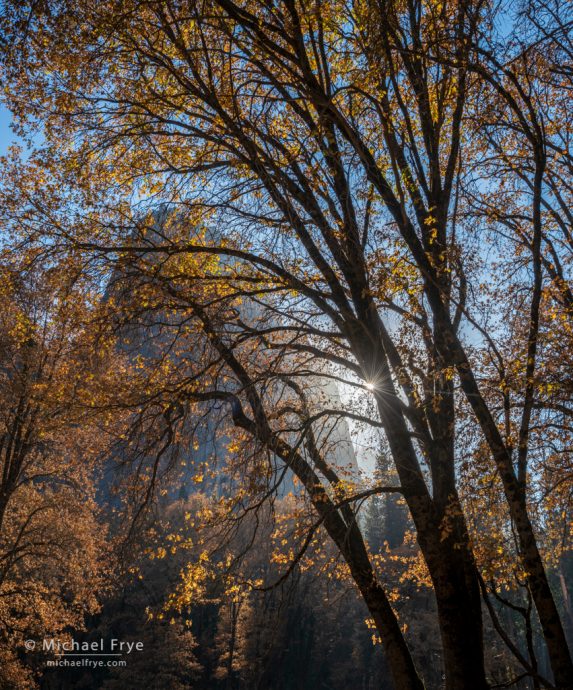
Oaks and Lower Cathedral Rock, Yosemite
As our Thanksgiving holiday approaches, Claudia and I have been reflecting on all the things we have to thankful for. It’s easy to feel gratitude for the big things in life, like your health, wealth and general happiness. But in the wake of recent fires and hurricanes, Claudia and I find ourselves feeling grateful for all the little things that we often take for granted – especially our home, with running water, electricity, wood for our stove to keep us warm, a safe place to welcome family and friends.
We’re grateful that our son is happy and healthy. We’re grateful for each other. I’m so lucky to have had such a wonderful partner for over 30 years!
And I am always so grateful for you, my readers. Your support, comments, and emails make writing this blog fun. Thank you!
Whether or not you celebrate Thanksgiving, Claudia and I hope you all have a lot to be thankful for!
— Michael and Claudia
by Michael Frye | Nov 18, 2018 | Uncategorized
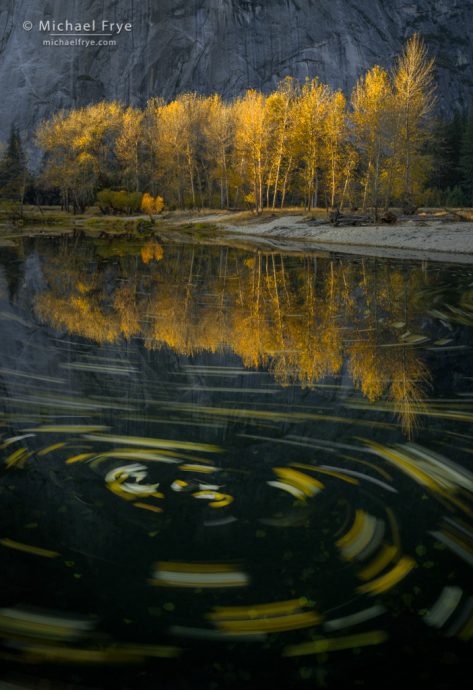
Cottonwood leaves swirling in the Merced River, Yosemite NP, CA, USA
Our country has endured so many disasters lately. The recent fires in California have been devastating – especially the Camp Fire that destroyed the town of Paradise. My mom lived in Paradise for eight years, and although I haven’t been there in decades, I remember the area well. I wonder whether any of her friends were still there. I’m sure her old house was destroyed; I just hope whoever was living there got out safely.
At least two members of our landscape-photography community lived in Paradise and lost nearly everything in the fire: Cindy Hoover and Erin Babnick. Please consider helping them out by contributing to the GoFundMe campaigns that have been set up for them: Cindy’s here, and Erin’s here.
(more…)
by Michael Frye | Nov 15, 2018 | Announcements
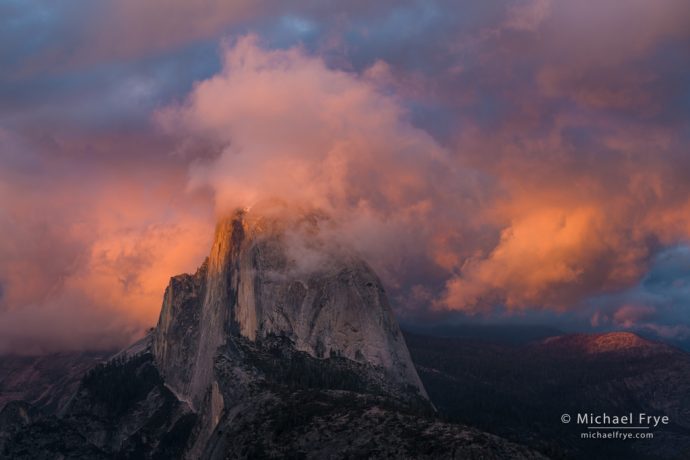
Glacier Point Sunset, Yosemite
Just a quick reminder that the holiday print sale ends tomorrow (Friday, November 16th) at midnight Pacific time, so you still have time to get 25% off on three images: Glacier Point Sunset, Yosemite; Milky Way over Sand Dunes, Death Valley; and Aspens and Ferns, Kebler Pass, Colorado.
In case you missed the earlier post, you can see the available sizes and sale prices underneath the descriptions of each image below.
(more…)
by Michael Frye | Nov 11, 2018 | Travels and Stories
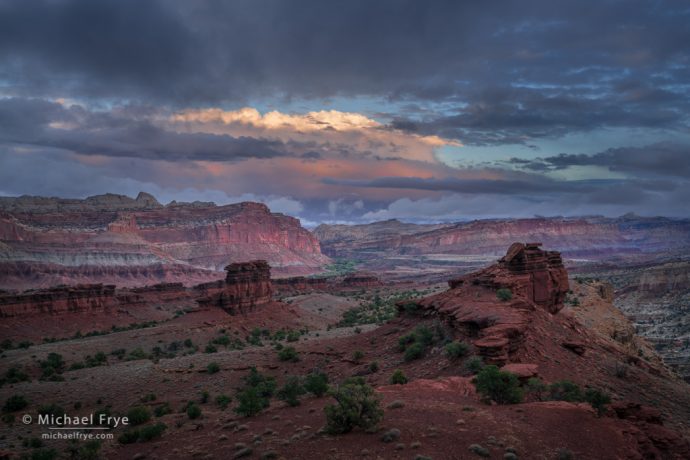
Storm clouds at sunset, Capitol Reef National Park, Utah
On our way back from Colorado last month, Claudia and I spent a couple of nights in southern Utah. We had dinner with one of Utah’s most talented and thoughtful photographers, Guy Tal, along with his wife Sarah. (If you’re not familiar with Guy’s photography and writing you should be!) And we enjoyed the change in scenery, going from the forested, snowy mountains of Colorado to the red-rock canyons.
(more…)
by Michael Frye | Nov 7, 2018 | Announcements
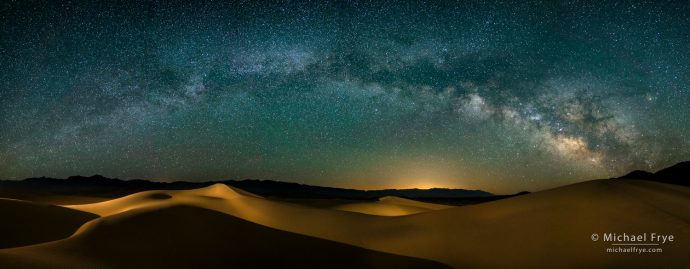
Milky Way over Sand Dunes, Death Valley
The print sale has ended, but you can still order prints at the regular price below.
I’m pleased to announce that we’re having a holiday sale on three prints never offered before, at 25% off the normal price. For this sale we’ve selected three popular images: Milky Way over Sand Dunes, Death Valley; Glacier Point Sunset, Yosemite; and Aspens and Ferns, Kebler Pass, Colorado.
The discounted pricing will last until Friday, November 16th. You can see the available sizes and sale prices underneath the descriptions of each image below.
(more…)
by Michael Frye | Nov 4, 2018 | Travels and Stories, Yosemite Photo Conditions
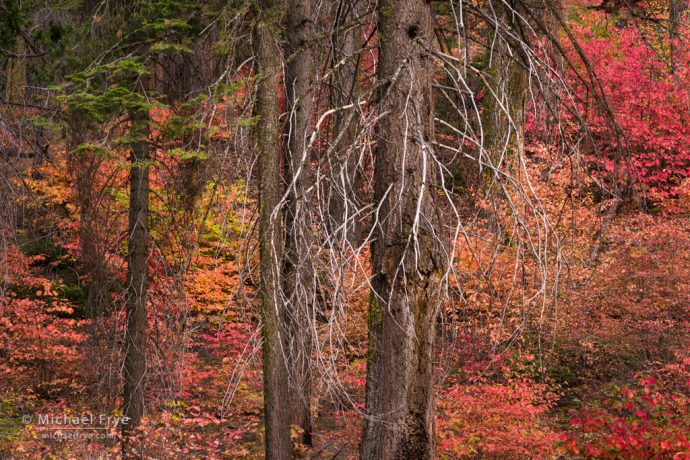
Firs and dogwoods, autumn, Yosemite. Dogwoods have proliferated in this area burned by the Rim Fire in 2013. 116mm, 15 seconds at f/16, ISO 100.
One afternoon about ten days ago Claudia and I headed up Highway 120, west of Yosemite Valley, to check on the fall color. We found some colorful dogwoods between the Valley and Crane Flat, but west of Crane Flat most of the dogwoods were brown, scorched by the Ferguson Fire last summer. Or, to be more accurate, they had been scorched by firing operations (back burns) performed by firefighters along the road.
We decided to hike down to the Tuolumne Grove of giant sequoias. While the Ferguson Fire didn’t reach the Tuolumne Grove, the Rim Fire did in 2013. The media latched onto this story, with headlines about the fire threatening these ancient trees.
(more…)
by Michael Frye | Oct 31, 2018 | Advanced Techniques, Photography Tips
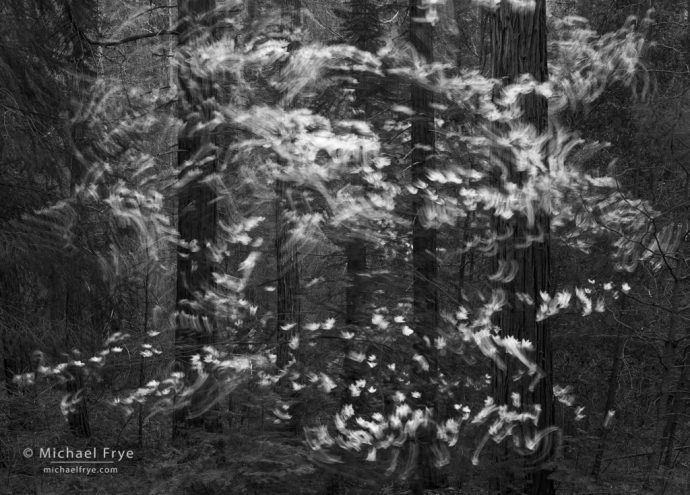
Swirling dogwood blossoms, Yosemite. I used a slow shutter speed (1/2 second) to deliberately blur the motion of these dogwood blossoms, but usually I’m trying to make my photos as sharp as possible.
It’s always disappointing to find out that one of your photos isn’t sharp – especially if it’s an image you like (and you weren’t trying to deliberately blur the image). Yet we all make mistakes. Even professionals like me sometimes take unintentionally blurry photos (as you’ll see below!). But after you’ve swallowed your disappointment, it’s important to figure out why the image is soft so that you don’t make the same mistake again.
There are basically five causes of blurry photos: camera movement, subject movement, missed focus, insufficient depth of field, and lens softness.
(more…)
by Michael Frye | Oct 28, 2018 | Uncategorized
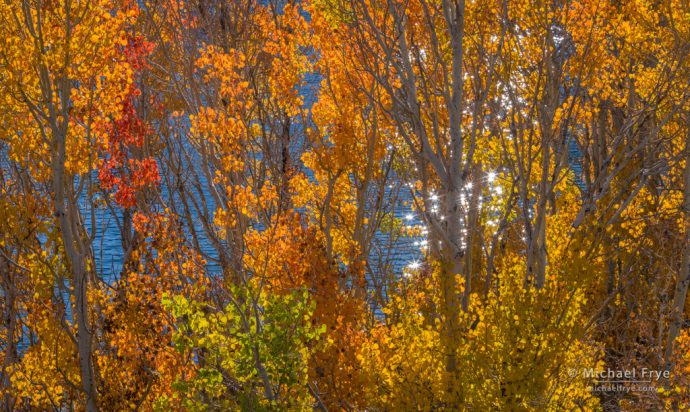
Autumn Colors: Sunlit reflections of Aspens above Grant Lake, Inyo NF, CA, USA
I’m working on a longer post, but in the meantime here are some more autumn colors, this time from the eastern Sierra about ten days ago. This image was actually Claudia’s idea. It’s difficult to photograph directly toward sunlit reflections like this, but she liked the color palette of yellow, orange, green, red, and blue, so I decided to try it, and somehow it worked.
(more…)
by Michael Frye | Oct 23, 2018 | Light and Weather
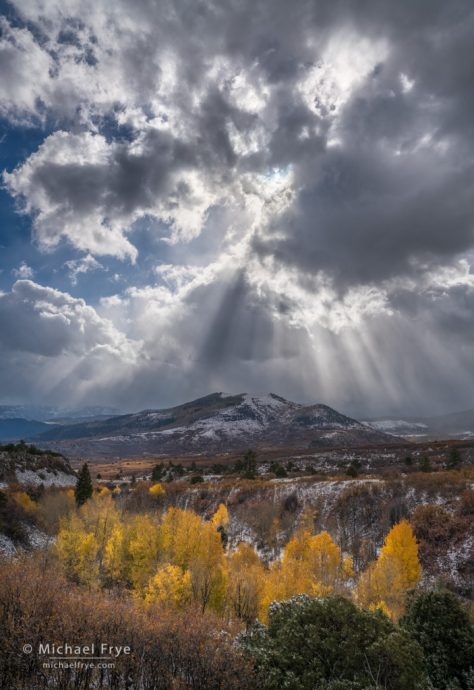
Sunbeams and aspens, Dallas Divide, Colorado. Claudia and I were headed to a more distant aspen grove, hoping to find snow on the trees, but saw some great sunbeams breaking through the clouds and decided to stop at Dallas Divide. We ended up staying for half an hour, with sunbeams moving across the landscape the whole time. For this image I bracketed five shots, two stops apart, and blended them with Lightroom’s HDR Merge.
In my last post I mentioned how much I love the transition from autumn to winter, with splashes of yellow amidst beautiful white aspen trunks, snow etching the trees, and the feeling of the long, cold winter settling in. Here are a few more attempts to capture that mood from the mountains of Colorado.
(more…)
by Michael Frye | Oct 21, 2018 | Light and Weather
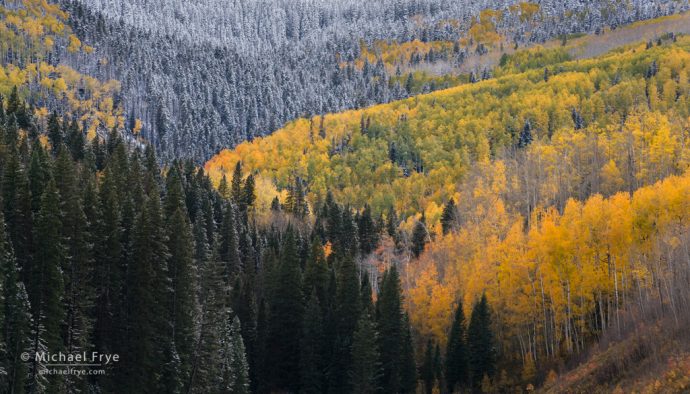
Hillside with aspens and conifers, Uncompahgre NF, CO, USA
We were in Colorado for two-and-a-half weeks, and during that time we watched the upper-elevation aspens lose most of their leaves. The lower-elevation aspens followed, going from green, to yellow and orange, and then, in some cases, bare. Rain and snow set in, and we saw the snow level drop from 11,000 feet down to 10,000 feet, then 9,000 feet, and even briefly down to 8,000 feet. It felt like winter was approaching rapidly.
(more…)


















